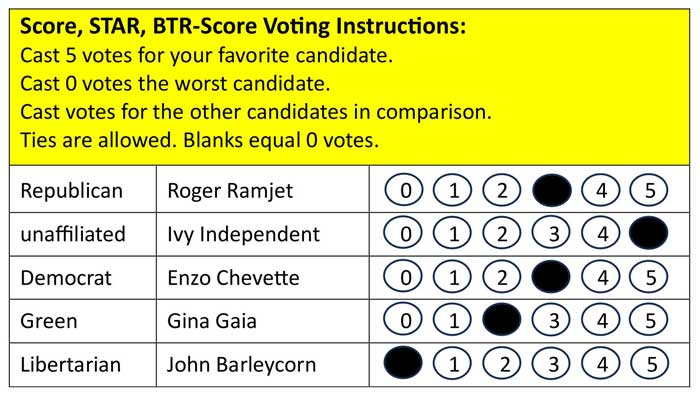Score Voting Methods – Score, STAR, and BTR-Score
Score methods combine fairness, reliability, and simplicity.
Score Voting is easy, it’s like rating products on Amazon.

Key Benefits of Score Voting Methods
Express Yourself
You can rate all candidates, rather than just voting “yes” for one candidate. Your ballot shows if you prefer candidate A to candidate D, and by how much you prefer A to D.
Civilized Campaigns
Score methods will calm campaigns. Voters may punish divisive campaign tactics with low scores. Candidates will need high scores from their base while avoiding low scores. Parties have a strong incentive to nominate candidates who can pull this off.
Fairness 1 – Safely Vote for Your Favorite Candidate
With traditional Choose 1 voting, you often must vote for the “lessor of two evils” instead of your favorite candidate. This is unfair to you and your favorite candidate. Score solves the problem by enabling you to rate all candidates.
Fairness 2 – Score Methods Eliminate the Spoiler Effect
Major party candidates lose votes to minor candidates with similar platforms. The spoiler effect beat Al Gore in 2000.[1] Will Trump or Biden be next?
Fairness 3 – Fair to Third Party & Independent Candidates
By allowing voters to rate all candidates, Score gives third-party and independent candidates a fair chance and a true voice. Because voters fear the spoiler effect, they seldom vote for the independent or third-party candidates they like. The lost votes make it difficult for third parties to recruit members, generate publicity, and raise campaign funds.
Fairness 4 – Score Does Not Exaggerate Major Party Support
Those lost votes go to major party candidates who are not the voter’s true favorite.
Fairness 5 – No Vote Splitting
In a Choose One race, two similar candidates will split the vote because you can only vote for one of them. Unfair to both you and the candidates. Score methods prevent vote splitting by letting voters rate both candidates.
Fairness 6 – High Voter Satisfaction and Turnout
Voters will enjoy having a powerful voice in fair elections. Voter turnout will grow.
Fairness 7 – Fewer Spoiled Ballots
Marking two candidates will spoil a Choose 1 ballot. A Ranked Choice ballot is spoiled if two candidates have an equal rank. No problem in either case on a Score ballot.
Choose One Problems are Common
The problems above occur regularly with Choose 1 voting. Voting system experts consider Choose 1, also known as plurality voting, to be near the bottom of the heap. Only Random Choice and Dictatorship are lower.
Choose One Voting Protects a Dysfunctional Duopoly
The advantages for the major parties lock in two-party rule. Score methods level the playing field.
Score, STAR, BTR-Score
Score, STAR, and BTR-Score have qualities that work well for elections in America.
Score Voting
Score Voting, also known as Range Voting, is easy for voters and easy to count. Total the votes for each candidate; the one with the most votes wins.
Strategy
The instructions encourage voters to use a basic strategy.
Cast 5 votes for your favorite candidate.
Cast 0 votes for the worst candidate.
Cast votes for the other candidates in comparison.
Ties are allowed. Blanks equal 0 votes.
It is always good strategy to give your favorite 5 votes. Strategic voters might give their favorite 5 votes and everyone else 0 votes. This could harm their second choice.
State Constitutions
Score voting complies with state constitutions that require a winning candidate to receive the “highest”, “greatest” or “largest” number of votes, or “a plurality of the votes”. Cases can be made that STAR and BTR-STAR also comply. Opponents will litigate against any new voting system.
STAR Voting – Score Than Automatic Runoff
STAR voting is easy. Cast your votes like Score voting. The top two candidates meet in an automatic runoff.
How STAR Voting Works
STAR ballots are counted in two rounds:
Round 1
Add up the votes for each candidate. The top two candidates meet in the Automatic Runoff.
Round 2
In the runoff, the candidate preferred on most ballots wins. If the two finalists are Ivy Independent and Roger Ramjet, and you gave Ivy 5 votes and only 3 votes to Roger, your vote would go to Ivy. The votes on your STAR ballot reveal which candidate you prefer in every one-on-one matchup.
STAR is a hybrid method designed to be neutral. STAR has no preference towards the middle or the extremes.
STAR has an extra level of resistance to strategic voting, so you can always vote sincerely.
STAR topped the charts in VSE (Voter Satisfaction Efficiency). So much so that Jonathan Quinn, the creator of VSE, recommends STAR Voting.[2] Both STAR and Score were well above Choose 1 and Ranked Choice Voting. BTR-Score was not included in the VSE study.
It is more work to count STAR ballots. Opponents will scream bloody murder, but it is not a big deal. Many nations have far more complex voting systems.
State Constitutions
The two candidates with the highest number of votes meet in STAR’s automatic runoff, where the candidate preferred by the highest number of voters wins with at least a plurality of the votes. Different state supreme courts may look at this differently.
The two candidates with the highest number of votes meet in STAR’s automatic runoff. The candidate preferred by the
BTR-Score – Score with Bottom Two Runoff
BTR-Score is like STAR, but the runoff includes every candidate.
Round 1
Voters use the same simple ballot as Score and STAR.
Additional Rounds
The bottom two candidates meet in Round 2. Like a STAR runoff, the candidate preferred on most ballots wins. The winner then goes against the next lowest candidate. This continues until only one candidate remains. That candidate is elected.
BTR-Score is even more resistant to strategy than STAR or Score. Like STAR, BTR-Score is a hybrid system; with a rated round, followed by one-on-one contests.
State Constitutions
In sports talk, the Round 1 votes seed a single elimination tournament.
Because the tournament includes all candidates and each contest is won by the candidate with the highest number of votes, BTR-Score complies with state constitutions that require the “highest”, “greatest” or “largest” number of votes, or “a plurality of the votes” to win. It has a stronger constitutional case than Ranked Choice Voting.
Elect the Candidate who Beats All Rivals
By including all candidates in the runoff, BTR-Score will always elect the candidate who beats all others one-on-one (if there is such a candidate). If there is not a candidate who beats all others one on one, BTR-Score will elect a deserving winner, the champion of the single elimination tournament.
Condorcet methods
Voting systems that always elect the “beats all” candidate are Condorcet methods. Elections without a Condorcet winner become quite rare as the number of voters increases. As a Condorcet method, BTR-Score is fair and reliable. Ramon Llull proposed the first “beats all” voting method in 1299. Nicolas Caritat, the Marquis de Condorcet, popularized the concept in the 18th century.
Help Break the Dysfunctional Duopoly of Power
By giving third-party and independent candidates a fair chance, Score voting will put a big dent in two-party rule. Proportional representation will break two-party rule. We will make American democracy greater than ever.
Score > RCV > Choose One
Score methods are preferred over Ranked Choice Voting, however RCV is superior to Choose One plurality voting.
To learn more about Ranked Choice Voting (RCV), also known as Instant Runoff Voting (IRV) visit our Ranked Choice Voting page.
For an examination of Choose 1 Voting please visit Choose 1 Plurality Voting Pros and Cons. Spoiler alert: The cons win.
Credits
The Center for Range Voting is the leading proponent of Score Voting. Their website
RangeVoting.org is an important source for this article.
Star Vote is the leading proponent of STAR voting. Visit them at StarVote.org
Star Vote is part of the Equal Vote Coalition. They study and advocate for many types of election reform. Learn more at Equal Vote Coalition
The Voting Theory Forum is an invaluable resource for the latest developments in Voting methods. It was particularly helpful with BTR-Score. Find the latest developments in voting systems at VotingTheory.org/forum/
[1] For more information about the spoiler effect in presidential elections please visit The Spoiler Effect in Presidential Elections


